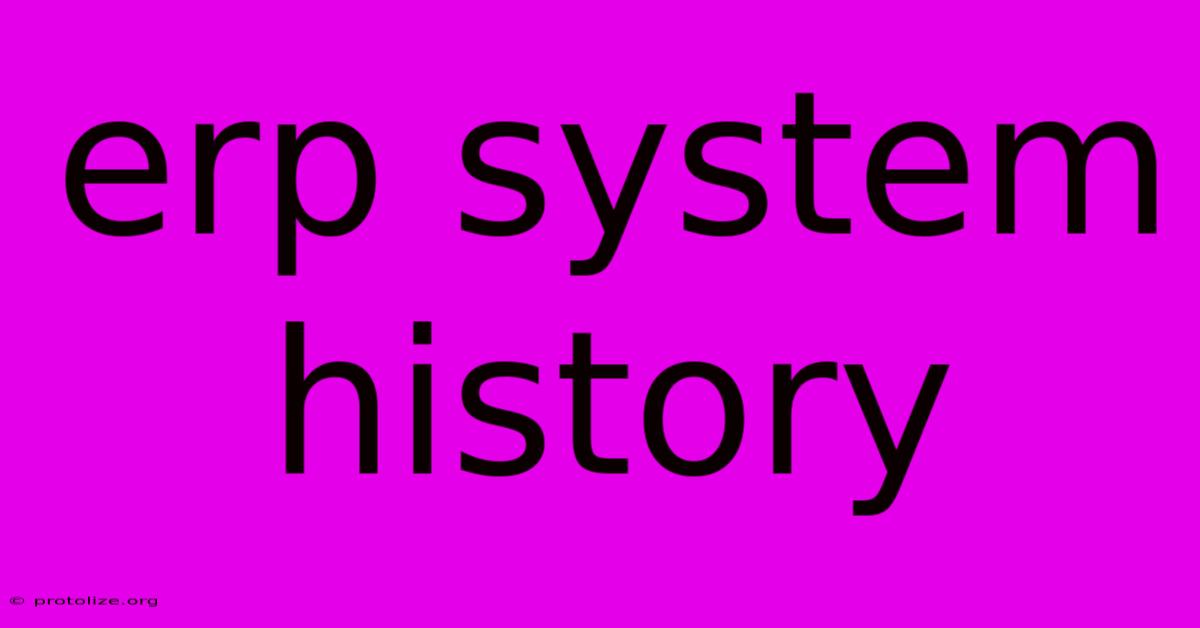Erp System History

Discover more detailed and exciting information on our website. Click the link below to start your adventure: Visit Best Website mr.cleine.com. Don't miss out!
Table of Contents
A Deep Dive into the History of ERP Systems: From MRP to Modern Cloud Solutions
Enterprise Resource Planning (ERP) systems are the backbone of modern businesses, streamlining operations and integrating crucial data across departments. But how did these complex systems evolve? This article explores the fascinating history of ERP, tracing its development from humble beginnings to the sophisticated solutions we use today.
The Genesis: Material Requirements Planning (MRP)
The roots of ERP can be traced back to the 1960s with the advent of Material Requirements Planning (MRP). MRP was a groundbreaking approach to inventory management, using a computer to calculate the precise quantities and timing of materials needed for production. This marked a significant shift from manual, often inaccurate, methods. While not an ERP system in itself, MRP laid the crucial foundation for the integrated systems to come. It addressed a key problem: optimizing inventory to avoid costly overstocking or production delays.
Key features of early MRP systems:
- Bill of Materials (BOM): A structured list of all materials needed to manufacture a product.
- Inventory Records: Tracking the current stock levels of all materials.
- Master Production Schedule (MPS): A plan outlining the quantity and timing of finished goods production.
Manufacturing Resource Planning (MRP II): Expanding the Scope
The limitations of MRP became apparent as businesses sought to integrate more aspects of their operations. This led to the development of Manufacturing Resource Planning (MRP II) in the 1980s. MRP II extended the functionality of MRP to encompass broader aspects of the manufacturing process, including capacity planning, shop floor control, and financial planning. This marked a crucial step toward a truly integrated system.
Significant advancements of MRP II:
- Capacity Planning: Ensuring sufficient resources (machines, labor) were available for production.
- Shop Floor Control: Tracking the progress of production orders in real-time.
- Financial Planning: Integrating production data with financial information for better forecasting and decision-making.
The Emergence of Enterprise Resource Planning (ERP): A Holistic Approach
The 1990s witnessed the full emergence of Enterprise Resource Planning (ERP) systems. Building on the foundations laid by MRP and MRP II, ERP systems broadened their scope to integrate all key business functions, including:
- Finance and Accounting: General ledger, accounts payable, accounts receivable.
- Human Resources: Payroll, benefits administration, recruitment.
- Supply Chain Management: Procurement, inventory management, logistics.
- Customer Relationship Management (CRM): Sales, marketing, customer service.
This holistic approach offered businesses unprecedented levels of integration and visibility across their entire operations. Early ERP systems, often implemented on-premise, were expensive and complex to implement, requiring significant IT expertise. However, the benefits of improved efficiency, reduced costs, and enhanced decision-making made them attractive to large organizations.
The Evolution of ERP: Cloud Computing and Modernization
The 21st century has brought about significant changes in ERP technology. The rise of cloud computing has transformed ERP systems, making them more accessible, affordable, and scalable. Cloud-based ERP solutions offer enhanced flexibility, reduced infrastructure costs, and automatic software updates.
Key trends shaping modern ERP:
- Cloud ERP: The shift from on-premise to cloud-based deployments is a dominant trend.
- Mobile Accessibility: Accessing ERP data and functionality on mobile devices is becoming increasingly important.
- Artificial Intelligence (AI) and Machine Learning (ML): Integration of AI and ML for predictive analytics, automation, and improved decision-making.
- Industry-Specific Solutions: Tailored ERP solutions are emerging to address the unique needs of different industries.
The Future of ERP
The history of ERP is a testament to the ongoing evolution of business technology. As businesses face increasing complexity and competition, ERP systems will continue to adapt and evolve, incorporating new technologies and functionalities. From its humble beginnings in inventory management, ERP has transformed into a critical element of business success, shaping the way organizations operate and compete in the digital age. The future likely holds further integration, greater automation, and even more sophisticated analytics, continuing to drive efficiency and innovation.

Thank you for visiting our website wich cover about Erp System History. We hope the information provided has been useful to you. Feel free to contact us if you have any questions or need further assistance. See you next time and dont miss to bookmark.
Featured Posts
-
Why Choose Cloud Erp
Dec 13, 2024
-
Kraven The Hunter Movie Review And Thoughts
Dec 13, 2024
-
Drivers In Flooded Boston Tunnel
Dec 13, 2024
-
49ers Lose Playoff Hopes Fade
Dec 13, 2024
-
Barcelona Wins Champions League Highlights
Dec 13, 2024
